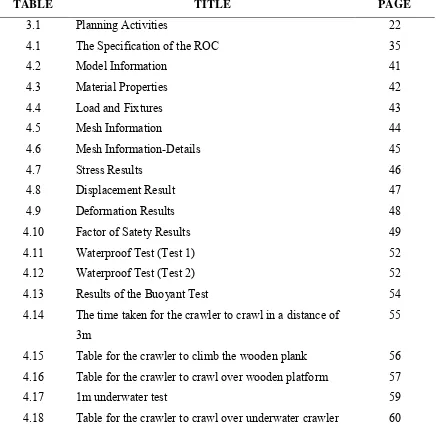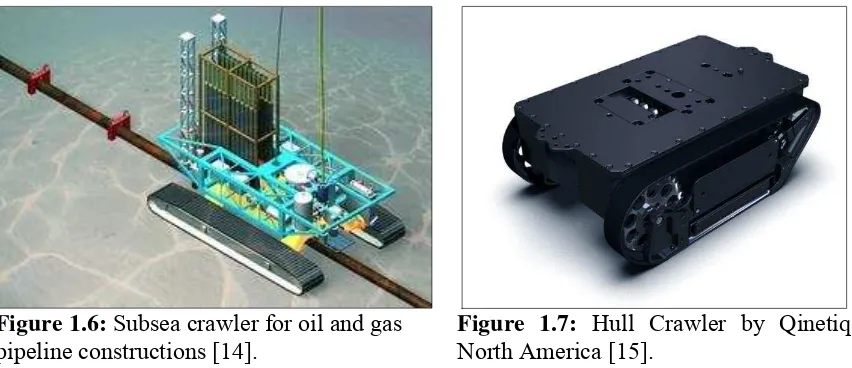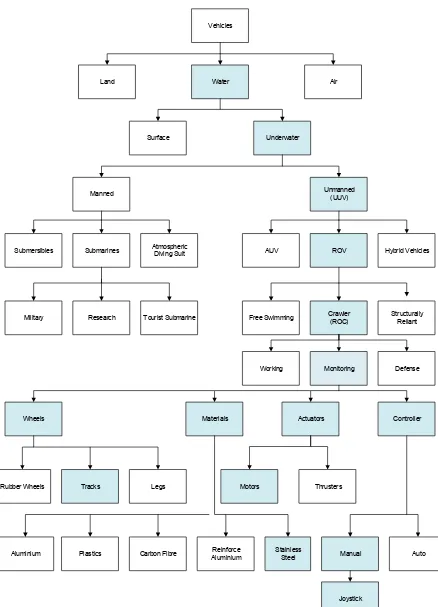DEVELOPMENT OF AN UNMANNED UNDERWATER REMOTELY OPERATED CRAWLER (ROC) BASED ON WHEEL MECHANISM
MUHAMMAD IKTISYAM BIN MOHD ZAINAL
AINE ILINA BINTI TARMIZI
I hereby declare that I have read through this report entitle “Development Of An Unmanned Underwater Remotely Operated Crawler (Roc) Based On Wheel Mechanism” and found that it has comply the partial fulfillment for Bachelor of Mechatronics Engineering.
Signature : ………...
Name : Dr. Mohd Shahrieel Mohd Aras
DEVELOPMENT OF AN UNMANNED UNDERWATER REMOTELY OPERATED CRAWLER (ROC) BASED ON WHEEL MECHANISM.
MUHAMMAD IKTISYAM BIN MOHD ZAINAL
A report submitted in partial fulfilment of the requirements for Bachelor of Mechatronics Engineering
Faculty of Electrical Engineering
UNIVERSITI TEKNIKAL MALAYSIA MELAKA
I declare this report entitle “Development Of An Unmanned Underwater Remotely Operated Crawler (Roc) Based On Wheel Mechanism” is the result of my own research except as cited in references. The report has not been accepted for any degree and is not concurrently submitted in candidature of any other degree.
Signature : ………... Name : Muhammad Iktisyam Bin Mohd Zainal
ACKNOWLEDGEMENT
v
ABSTRACT
ABSTRAK
vii
TABLE OF CONTENTS
CHAPTER TITLE PAGE
ACKNOWLEDGEMENT i
ABSTRACT iv
TABLE OF CONTENT vii
LIST OF TABLES x
LIST OF FIGURES xi
1 INTRODUCTION 1
1.1 Introduction 1
1.2 Motivation 3
1.3 Problem Statements 6
1.4 Objectives 9
1.5 Scopes and Limitations 9
2 LITERATURE REVIEW 11
Vehicle
2.3 Usage of Unmanned Underwater Vehicles in Industries 15
2.4 Design Comparison 16
2.4.1 Type of Wheels 16
2.4.2 Actuators 16
2.4.3 Controller 17
2.4.4 Materials Selection 17
2.5 Summary 18
3 METHODOLOGY 19
3.1 Introduction 19
3.2 Milestone and Project Planning 22
3.3 Data Collection 22
3.4 SolidWork 22
3.5 Electronic Structure 23
3.6 Gear Configuration 25
3.61 Gear Ratio Calculation 26
3.7 Experiment and Project Set Up 29
4 RESULT AND DISCUSSION 34
4.1 Introduction 34
4.2 Design of Remotely Operated Underwater Crawler 35
4.3 Chassis Simulation Test 39
ix
5 CONCLUSION AND RECOMENDATION 61
5.1 Conclusions 61
5.2 Recommendations 63
REFERENCES 64
LIST OF TABLES
TABLE TITLE PAGE
3.1 Planning Activities 22
4.1 The Specification of the ROC 35
4.2 Model Information 41
4.3 Material Properties 42
4.4 Load and Fixtures 43
4.5 Mesh Information 44
4.6 Mesh Information-Details 45
4.7 Stress Results 46
4.8 Displacement Result 47
4.9 Deformation Results 48
4.10 Factor of Satety Results 49
4.11 Waterproof Test (Test 1) 52
4.12 Waterproof Test (Test 2) 52
4.13 Results of the Buoyant Test 54 4.14 The time taken for the crawler to crawl in a distance of
3m
55
4.15 Table for the crawler to climb the wooden plank 56 4.16 Table for the crawler to crawl over wooden platform 57
4.17 1m underwater test 59
xi
LIST OF FIGURES
FIGURE TITLE PAGE
1.1 Helmet Suit by Carl Klingert 2 1.2 Charles William Beebe and Ortis Barton With Their
Bathysphere
2
1.3 Chart of World Fuels Production and Consumption from 2009 to 2015
3
1.4 The Fuel Consumption Graph from 2007 to 2015 4
1.5 Sakhalin Offshore Projects 5
1.6 Subsea Crawler for Oil and Gas Pipeline Constructions 6 1.7 Hull Crawler by Qinetiq North America 6
1.8 The K-Chart of the Project 10
2.1 Hybrid Robot Crawler / Flyer RGIII 17 2.2 Eca Hytec Roving Bat, Hybrid ROV for Inspection and
Cleaning
17
2.3 Qinetiq EOD Underwater Hull Inspection 18
2.4 Proposed Design 18
3.1 Process Flowchart 21
3.2 The SolidWork Drawing Interface 23
3.3 A PSC28A controller 24
3.4 Joystick or Controller for Playstation 2 24
3.5 Gear Configuration 25
3.6 Crawler Gear Ratio Configuration Design 28 4.1 Assembly Design of the Crawler 35
4.2 The Prototype of ROC 36
chassis
4.5 The control box 38
4.6 The circuit of the controller 38 4.7 Chassis is submersed to identify any leaking 50 4.8 The crawler is sealed and tested for any leakage 51 4.9 Iron column is added to overcome the buoyant force 53 4.10 Comparison chart between surfaces against the time
taken
55
4.11 The ability of the crawler to climb chart 57 4.12 The crawler climbed the 9.5 cm obstacles 58
4.13 Underwater time result 59
1
CHAPTER 1
INTRODUCTION
This chapter is introduction of the project that covers briefly about the research background. The motivation and significant of the research is also included in this chapter. By motivation, the problem statement of this project has been concluded. The objectives of the project also explained in detail. In this chapter, the project scopes are determined and lastly, the report outline is executed.
1.1Introduction
Figure 1.1: Helmet Suit by Karl Klingert [1]. Figure 1.2: Charles William Beebe and Ortis Barton with their bathysphere [1].
3
1.2Motivation
Oil and gas have become an essential to us. The oil and gas industries give a lot of impact in our civilization. With this type of commodity, many new inventions have been created, changes the landscape of a country, economic growth and more in our life. Most of the time in our daily life related to petroleum base products. As a report by U.S Energy Information Administration (EIA), for the year 2013, United States consumed 6.89 billion barrels of petroleum products at the rates of 18.89 million barrels per day (bbl/d) [3]. In Figure 1.3 shows the world fuel consumption over the year 2009 until 2014 and expected projection in 2015. U.S. Energy Information Administration (EIA) projects world petroleum and other liquids supply to increase by 1.6 million bbl/d in 2014 and by 0.9 million bbl/d in 2015, with most of the growth coming from countries outside of the Organization of the Petroleum Exporting Countries (OPEC). The graph of the world liquid fuels consumption as shown in Figure 1.4. Forecast non-OPEC supply grows by 1.9 million bbl/d in 2014 and 1.2 million bbl/d in 2015. The United States and Canada account for much of this growth. Projected world liquid fuels consumption grows by an annual average of 1.0 million bbl/d in 2014 and 1.2 million bbl/d in 2015 [4].
Figure 1.4: The fuel consumption graph for the year 2007 to 2015 [5].
The exploration of the oil and gas industries is not concentrated at on the land, but also in the offshore and deep sea as more oil wells found. Thus, as offshore explorations have increase the risk taken by man and women to drill petroleum. There are many cases regarding on the drilling, pipelines, transportation and storage accidents. Even though there are safety measures performed, yet accident can happen anytime without notice.
5
Figure 1.5: Sakhalin Offshore Projects [5].
Modern technology of pipeline construction and exploitation have been introduced. For example the usage of ROV and ROC in construction the underwater pipeline connections. This technology eliminates the risk taken by divers to dive into the deep and cold water condition. The ROC used in pipeline inspections and even constructions on the seabed along with other types of ROV and reduce human intervention doing the welding and inspection process.
Figure 1.6: Subsea crawler for oil and gas
pipeline constructions [14]. Figure 1.7:North America [15]. Hull Crawler by Qinetiq
1.3 Problem Statements
The ROV is widely use in sea exploration. Even that so, it has limitations regarding on usage on the seabed. This ROV just at the certain depth and cannot operated in the cluttered environment as expected and direct contact with the seabed. Besides that, the ROV will cause sediment or mud on the seabed to shake and reduce visualization. It is also unstable due to the effect of environmental disturbance such as sea waves, current and unexpected underwater condition.
Investigation have been done in designing an unmanned underwater vehicle (UUV). The most problems are more regarding on the reliability of the UUV to work underwater without any glitch. Tadahiro Hyakudome (2011) from the Japan Agency for Marine-Earth Science and Technology (JAMSTEC) [7], Japan has listed a few problems in designing a UUV such as the seawater and water pressure environment, sinking capability, power unit and controller design. The author also stated that:
”When such underwater vehicles are made, it is necessary to consider about the following things such as seawater and water pressure environment, sink, there are no gas or battery charge stations, Global Positioning System (GPS) cannot use and radio waves cannot be used.”
7
influences the pressure exerted. Hence, it is important to determine the pressure exerted so that the structure will not collapse or buckling. Besides that, the underwater environments are unpredictable. Underwater conditions can change anytime. Climate can affect the tides of the shore, waves, temperature and wind. Without proper design and material selections, the structure of the ROC can damage.
Designing a frame and determine the best material could give a headache. From the journal written by researchers in Ocean Engineering at Florida Institute of Technology, USA, they tested every frame’s design using many type materials. Modification and strengthening of the frame was necessary after cracks were discovered in several welds of motor support. Adding ribs to the outer frame support between the main frame of the crawler and the motor housing frame made of 1/4” 6061-T6 aluminium solved this issue [8]. The stress on the frame must be considered and choosing the best materials are required. The materials must be lightweight yet strong enough to support the ROC motor and components and withstand the force and pressure. Some materials to be considered in the design are titanium, carbon fibre and aluminium.
the main issues to consider. Designing, development and research of the power source, following things need to be considered:
1. Size and light weight 2. Resist to pressure and water
3. Reliability to supply enough power
4. Maintenance of the power unit (rechargeable or not) 5. Power capacity
6. Low vibration and produce noise
For communication, radio wave is not usable in the sea or underwater. However, it is crucial for ROC or ROV to communicate with the support vessel. The effective method of underwater communication is acoustic telemetry. There are analogue and digital communication for acoustic telemetry [7]. The controller for some ROC design split into two analogue and digital. The analogue use relays while digital uses an Arduino micro-controller. The usage of cables gives less mobility to the ROC since the seabed is not flat and have obstacles.
9
1.4 Objectives
The purposes of developing an unmanned underwater Remotely Operated Crawler (ROC) as follows:
1. To design and analysis of unmanned underwater Remotely Operated Crawler (ROC) using CAD software.
2. To develop a Remotely Operated Crawler (ROC) based on the selected design. 3. To analyze the movement and maneuvering of the Remotely Operated Crawler
(ROC) underwater and on land.
1.5 Scopes and Limitations
Land Water Air
Surface Underwater
Manned Unmanned (UUV)
Submarines
Submersibles Atmospheric Diving Suit AUV ROV Hybrid Vehicles
Military Research Tourist Submarine Free Swimming Crawler (ROC) StructurallyReliant
Materials
Wheels Actuators Controller
Rubber Wheels Tracks Legs
Carbon Fibre AluminiumReinforce Plastics
Aluminium
Motors Thrusters
Auto Manual
Joystick Stainless
Steel
Working Monitoring Defense

![Figure 1.1: Helmet Suit by Karl Klingert [1].](https://thumb-ap.123doks.com/thumbv2/123dok/492022.54424/16.595.91.236.91.259/figure-helmet-suit-by-karl-klingert.webp)
![Figure 1.3: Chart of world fuels production and consumption for the year 2009 to 2015 [3]](https://thumb-ap.123doks.com/thumbv2/123dok/492022.54424/17.595.174.436.467.677/figure-chart-world-fuels-production-consumption-year.webp)
![Figure 1.4: The fuel consumption graph for the year 2007 to 2015 [5].](https://thumb-ap.123doks.com/thumbv2/123dok/492022.54424/18.595.173.452.69.282/figure-fuel-consumption-graph-year.webp)
![Figure 1.5: Sakhalin Offshore Projects [5].](https://thumb-ap.123doks.com/thumbv2/123dok/492022.54424/19.595.168.444.71.347/figure-sakhalin-offshore-projects.webp)

